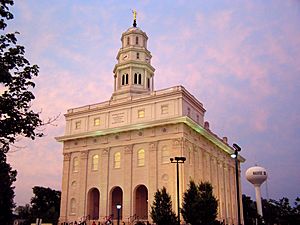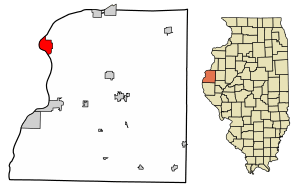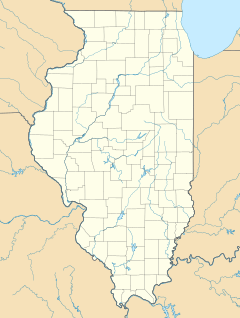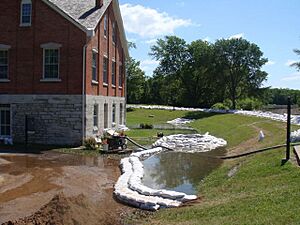Nauvoo, Illinois facts for kids
Quick facts for kids
Nauvoo
Quashquema, Venus, Commerce
|
|
|---|---|
| City of Nauvoo | |

The rebuilt Nauvoo Temple was completed in 2002.
|
|

Location of Nauvoo in Hancock County, Illinois.
|
|
| Country | |
| State | |
| County | Hancock |
| Townships | Nauvoo, Sonora |
| Area | |
| • Total | 4.83 sq mi (12.50 km2) |
| • Land | 3.39 sq mi (8.77 km2) |
| • Water | 1.44 sq mi (3.73 km2) |
| Elevation | 574 ft (175 m) |
| Population
(2020)
|
|
| • Total | 950 |
| • Density | 280.57/sq mi (108.32/km2) |
| Time zone | UTC-6 (CST) |
| • Summer (DST) | UTC-5 (CDT) |
| ZIP code |
62354
|
| Area code(s) | 217 |
| FIPS code | 17-51791 |
| GNIS feature ID | 2395160 |
Nauvoo (pronounced NAW-voo) is a small city in Hancock County, Illinois, United States. It sits right by the Mississippi River, close to Fort Madison, Iowa. In 2020, about 950 people lived there.
Nauvoo is a popular place for visitors because of its rich history. It's especially important to members of several religious groups, including The Church of Jesus Christ of Latter-day Saints and the Community of Christ. Other groups from the Latter Day Saint movement and the Icarians also find it significant. The city and its nearby areas are recognized as the Nauvoo Historic District on the National Register of Historic Places.
Contents
The Early Days of Nauvoo
The area where Nauvoo is located today was first known as Quashquema. This name honored a Native American chief. His Sauk and Meskwaki tribe had a settlement of almost 500 lodges here.
By 1827, white settlers began building cabins in the area. In 1829, the population of this part of Hancock County grew enough to need a post office. By 1832, the town, then called Venus, was considered for the new county's main city. However, a nearby city, Carthage, was chosen instead. In 1834, the settlers changed the name from Venus to Commerce. They felt this new name better suited their plans for the growing town.
How Nauvoo Got Its Name
In late 1838, a leader named Brigham Young advised some members of the Latter Day Saint movement to leave Far West, Missouri. They needed to find a safe place for over 12,000 people who had lost their homes. One of these travelers, Israel Barlow, met Dr. Isaac Galland. Dr. Galland owned land near Montrose, Iowa, and Commerce, Illinois.
When Dr. Galland heard about the difficult situation of these people, he offered to sell them his properties on good terms. Barlow shared this offer with the Church leaders. The Church bought the land from Galland in 1839. Many people who had been spread out began to gather again, especially along the Mississippi River at Commerce.
In April 1840, Joseph Smith, who led the Latter-day Saints, renamed Commerce to Nauvoo. He had brought his followers there to find peace after difficulties in Missouri. The name Nauvoo comes from the traditional Hebrew language. It means 'they are beautiful'. By 1844, Nauvoo's population had grown to 12,000 people. This made it similar in size to Chicago at that time.
John C. Bennett, an important leader, was elected mayor of Nauvoo in 1841. Joseph Smith himself became mayor in 1842. After Smith's death two years later, ongoing problems with people outside their group caused most Latter-day Saints to leave Nauvoo. Many of these followers, led by Brigham Young, traveled to the Great Salt Lake Valley.
In 1849, a group called the Icarians moved to Nauvoo. They wanted to create a special community based on the ideas of French philosopher Étienne Cabet. This community, or commune, had almost 500 members at its busiest time. However, when Cabet died in 1856, some members left the group.
After the Icarians left, Nauvoo became the largest German-speaking community in Illinois for 50 years. German was widely spoken in town and in many churches. During this time, making wine and growing fruit became very successful in Nauvoo. Famous people from this time include the Swiss writer Heinrich Lienhard. During World War I, most German-speaking residents in Nauvoo stopped using German in public. By World War II, the use of German had almost completely disappeared.
Nauvoo Today: A Historic Destination
Today, on the higher parts of the city, you'll find the temple, homes, and the main business area along Mulholland Street (Illinois Route 96). Much of this area is focused on helping tourists and those interested in Latter-day Saint history.
The lower, flatter parts of the city have some 19th-century brick houses and other buildings that have lasted through time. There are large empty spaces between them where many old houses and even whole neighborhoods used to be.
Historic Sites and Restoration Efforts
The Community of Christ used to own many important historic sites in Nauvoo. These included the Joseph Smith Homestead, the Nauvoo House, the Red Brick Store, the Mansion House, and the Smith Family Cemetery. On March 5, 2024, it was announced that The Church of Jesus Christ of Latter-day Saints had bought most of these properties. The Smith Family Cemetery was the only exception. This was part of a larger exchange of important historical places and items between the two churches.
The Church of Jesus Christ of Latter-day Saints also owns most of the other historic sites in Nauvoo. These include the homes of Brigham Young, Heber C. Kimball, and other early church members. Many of these sites are open to the public. You can see demonstrations and displays, and take self-guided driving tours or wagon tours. These tours are free, as are the stage shows and riverside plays. There is also a large visitors' center with two theaters and a map of Nauvoo from 1846.
Making Nauvoo a place for historical tourism was largely due to the efforts of J. LeRoy Kimball (1901–1992). Kimball was a descendant of an early church leader, Heber C. Kimball. In 1954, he bought his ancestor's home with the goal of fixing it up. He was the president of Nauvoo Restoration, Inc. from 1962 to 1986.
A congregation of The Church of Jesus Christ of Latter-day Saints was started in Nauvoo in 1956. From the beginning, it was mostly made up of older church couples who served as missionaries and historical guides. The City of Joseph pageant, an outdoor musical produced by the Church, began running every summer in 1976. A stake (a larger church unit) was formed in Nauvoo in 1979. Besides the many homes that were restored, the Relief Society Memorial Garden was dedicated in 1978. It features statues created by Dennis Smith and Florence Hansen.
The Nauvoo Temple Today
In June 2002, The Church of Jesus Christ of Latter-day Saints finished building a new temple on the same spot as the original temple. The outside, and much of the inside, looks just like the first one. The exterior is an exact match except for three small differences:
- The temple was moved about 12.5 feet (3.8 meters) south to make space for parking on the north side.
- There are two new outside doors. One is an entrance on the north for people with disabilities, and there are emergency exits in the basement on the east.
- There is a standing Angel Moroni statue, like on most modern temples. The original temple had a different kind of flying angel.
The rebuilding of the Nauvoo Temple brought great happiness to members of The Church of Jesus Christ of Latter-day Saints. Before it was officially dedicated, 331,849 visitors toured the building during a public open house. Following church tradition, the temple is now used only by church members.
The work to fix up various historic sites in the area is managed by Nauvoo Restoration, Incorporated (NRI). NRI is a non-profit group supported by The Church of Jesus Christ of Latter-day Saints and Community of Christ. Other people interested in Nauvoo's history also support it. Because of NRI's work, Nauvoo has been called the "Williamsburg of the Midwest." In March 2007, Nauvoo was chosen to compete as one of the Seven Wonders of Illinois.
The Church of Jesus Christ of Latter-Day Saints supports many activities throughout the year in Nauvoo. This includes The Nauvoo Pageant, which usually runs in July and August. (The 2020 pageant was canceled due to the COVID-19 pandemic.) The community also holds the Grape Festival (Labor Day weekend) and the Pumpkin Walk (October).
Most of the city is well above the river's flood level. Because of this, Nauvoo has not had many problems when the Mississippi River rises. In both the 1993 and 2008 floods, very little damage happened within the city limits. Maps show that Nauvoo has a unique shape. Its main street starts at the Mississippi River on the south side of town and ends at the river's edge on the north.
Nauvoo has many places of worship. These include:
- United Methodist Church
- St Peter & Paul Catholic Church
- Cornerstone of Zion Church
- Living Hope Church (Non-denominational)
- A Community of Christ church (formerly The Reorganized Church of Jesus Christ of Latter-day Saints)
- Three wards (local congregations) of The Church of Jesus Christ of Latter-day Saints.
Nauvoo's Location and Landscape
Nauvoo is located at 40.5446 degrees North latitude and -91.3803 degrees West longitude. It sits on a wide curve of the Mississippi River. Most of the historic district is in the lower, flat lands, which are only a few feet above the water. This area is called the flats.
As you move further east, a noticeable hill rises. At the top of this hill stands the rebuilt Nauvoo Temple. This higher land, called the uptown, continues flat for many miles to the east.
According to 2021 information, Nauvoo covers a total area of about 4.83 square miles (12.50 square kilometers). Of this, about 3.39 square miles (8.77 square kilometers) is land, and 1.44 square miles (3.73 square kilometers) is water.
Population Changes in Nauvoo
| Historical population | |||
|---|---|---|---|
| Census | Pop. | %± | |
| 1840 | 2,450 | — | |
| 1850 | 1,130 | −53.9% | |
| 1860 | 1,394 | 23.4% | |
| 1870 | 1,578 | 13.2% | |
| 1880 | 1,402 | −11.2% | |
| 1890 | 1,208 | −13.8% | |
| 1900 | 1,321 | 9.4% | |
| 1910 | 1,020 | −22.8% | |
| 1920 | 972 | −4.7% | |
| 1930 | 966 | −0.6% | |
| 1940 | 1,088 | 12.6% | |
| 1950 | 1,242 | 14.2% | |
| 1960 | 1,039 | −16.3% | |
| 1970 | 1,047 | 0.8% | |
| 1980 | 1,133 | 8.2% | |
| 1990 | 1,108 | −2.2% | |
| 2000 | 1,063 | −4.1% | |
| 2010 | 1,149 | 8.1% | |
| 2020 | 950 | −17.3% | |
| U.S. Decennial Census | |||
Records not from the official census show that Nauvoo's population grew quickly. It went from 100 people in 1839 to about 4,000 in 1842. By 1844, it reached 12,000, and in 1845, it was around 11,000.
Nauvoo's Population in 2020
Based on the 2020 census, there were 950 people living in Nauvoo. These people made up 313 households, with 245 of them being families. The city had about 196.81 people per square mile (108.32 people per square kilometer). There were 645 housing units, meaning homes or apartments.
The racial makeup of the city was mostly White people (90.95%). A small number were African American (0.32%), Native American (1.16%), Asian (0.21%), or Pacific Islander (0.11%). About 1.26% were from other races, and 6.00% were from two or more races. People who identified as Hispanic or Latino made up 2.84% of the population.
Out of the 313 households, 33.2% had children under 18 living with them. About 67.41% were married couples living together. About 7.67% had a female head of household with no husband present. About 21.73% were not families. Around 17.25% of all households were made up of individuals. Of these, 9.27% had someone living alone who was 65 years old or older. The average household had 3.15 people, and the average family had 2.88 people.
The city's population had a varied age distribution. About 25.4% were under 18 years old. About 7.7% were from 18 to 24. About 27.6% were from 25 to 44. About 10.6% were from 45 to 64. And 28.7% were 65 years old or older. The median age was 38.6 years. For every 100 females, there were about 116.4 males. For every 100 females aged 18 and over, there were about 104.9 males.
The average income for a household in the city was $50,938. For families, the average income was $53,224. Males had an average income of $38,500, while females had an average of $12,708. The per capita income (average income per person) for the city was $20,386. About 23.3% of families and 30.2% of the total population lived below the poverty line. This included 36.9% of those under 18 and 8.5% of those 65 or older.
Nauvoo's Economy and Industries
The Nauvoo Blue Cheese company started making cheese in the 1930s. They found that the cool, moist wine cellars in the area were perfect for aging cheese. These wine cellars and the wine-making business, first started by the Icarians, were used less because of prohibition. In 2003, the Nauvoo Cheese company closed when Saputo food company bought it and moved its operations elsewhere.
Nauvoo is also home to Baxter's Vineyards. This is a small family-owned winery that began in 1857. It is the oldest established winery in Illinois.
Tourism is the main industry in Nauvoo. Nauvoo Restoration Inc. employs about 30 people. Also, an estimated 200 unpaid missionaries from The Church of Jesus Christ of Latter-Day Saints help local businesses during the tourist season.
Because there aren't enough steady industries, the city has lost several important businesses and services. This includes the High School and many small businesses.
Education in Nauvoo
The Nauvoo-Colusa Community Unit School District 325 manages the local elementary and junior high schools. Before 2008, high school students attended Nauvoo-Colusa High School from 1961 to 2008. Since 2008, students have attended Warsaw Community Unit School District 316's Warsaw High School.
Nauvoo also has a private school called Sts. Peter & Paul Catholic School. It offers a faith-based education for students from preschool through 6th grade.
Parks and Fun in Nauvoo
Nauvoo has three parks, one of which is a state park.
- Nauvoo City Park
- Nauvoo Park District
- Nauvoo State Park
Nauvoo's Infrastructure
Roads and Highways
- Illinois Route 96 (Mulholland St.) is a main road in Nauvoo.
Healthcare Services
Nauvoo is served by Memorial Medical Clinic. Its main hospital is about 24 miles (38.6 kilometers) east of Nauvoo. There is also a Walk-In Clinic located right within the city.
Notable People from Nauvoo
- Elijah Abel
- Israel Barlow
- Samuel Bent
- Lewis C. Bidamon
- Edward Bonney
- Anson Call
- George Q. Cannon
- Duncan Spears Casper
- Sarah M. Cleveland
- Ina Coolbrith
- Lorin Farr
- King Follett
- Robert D. Foster
- Isaac Galland
- Mary Field Garner
- Joseph L. Heywood
- Chauncey L. Higbee
- Francis M. Higbee
- Abraham Hoagland
- David Patten Kimball
- Hiram Kimball
- Martha McBride Knight
- Wilson Law
- Edwin T. Layton
- Heinrich Lienhard
- Lucy Smith Millikin
- Freeman Nickerson
- Stillman Pond
- Samuel W. Richards
- Miles Park Romney
- James Sloan (Latter Day Saints)
- Alexander Hale Smith
- David Hyrum Smith
- Elbert A. Smith
- Emma Smith
- Joseph Smith
- Joseph Smith III
- Julia Murdock Smith
- Daniel Spencer (Mormon)
- John Taylor (Mormon)
- Ezra Thayre
- Alice Willard
- Ann Eliza Young
See also
 In Spanish: Nauvoo para niños
In Spanish: Nauvoo para niños







